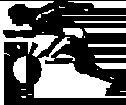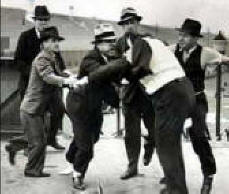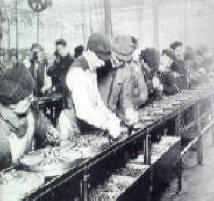Action Learning
Strategy, Tactics & Corporate Culture
Strategy Versus Tactics

Strategic issues relate to the long-term, difficult-to-change elements of a business that create competitive advantage. They are elements thatcompetitors cannot quickly duplicate.
Action Learning is a strategic tool because it changes corporate culture. It encourages people to examine the mental models of the current culture as well as their own assumptions, prejudices, beliefs and mental models. As this re-examination migrates through the organization, it allows for the possibility of creating new models and beliefs that are more consistent with the current environment, more productive and more conducive to company survival.
Corporate Culture
Corporate culture is usually the most strategic of these elements. It is notoriously resistant to change, particularly in larger organizations. Attitudes, policies, practices and behaviors are unconsciously interwoven into the daily patterns of employees.
Many companies find success with approaches to business that suits a particular time and technology. Then, when external conditions change the organization cannot cope because the culture perpetuates the original formula. When changes are made in some organizational areas, the mental models in surrounding functions and areas resist. The changes then revert as the pervasive influence of culture restores things to fit the original mental models.
The Ford Example
Ford Motor Company during the 1930s and 1940s is a well-known example of this.
The problems at Ford during this period were generally blamed on the founder and his peculiar personality. That is certainly true in the sense that Henry Ford established the culture.
However, this author worked at Ford in the late 1960's, nearly two decades after Henry Ford's death and there were still many of his counter-productive attitudes and policies in place. The corporate culture originated by Henry Ford I outlived him by at least several decades. I suspect that it may still be an influence.
The same phenomena affects the other Detroit automotive companies and is largely responsible for their recent troubles. When it comes to cultural change, the only certain things are uncertainty, inertia and difficulty. This is the least understood and most troublesome aspect of a Lean implementation. Action Learning can help.

Battle of The Overpass, 1937
Ford "Goon Squads" beat labor leaders Walter and Victor Reuther.

Ford Assembly Line, Circa 1913
Long hours, repetitive, unfulfilling tasks and harsh supervision made Ford Motor Company an unpleasant place to work.
Action Learning, Kaizen & Lean
 Given
wide range of practices, it can appear that Action Learning is little different from Kaizen Events or even ordinary task forces.
The differences can be subtle but important. All three approaches can (usually) solve the assigned problem. However, the longer range, strategic effects are radically different. Table 1
summarizes the commonalities and differences.
Given
wide range of practices, it can appear that Action Learning is little different from Kaizen Events or even ordinary task forces.
The differences can be subtle but important. All three approaches can (usually) solve the assigned problem. However, the longer range, strategic effects are radically different. Table 1
summarizes the commonalities and differences.
A task force may find a solution to the problem but the implementation is usually slow, painful and uncertain. When complete, the organization reverts to its normal modes of operation.
A typical Kaizen Event solves the problem and implementation is swift and sure. However, outside the immediate area that the problem has addressed, the organization reverts to its normal operating modes. Because the culture has not changed, the benefits of the Kaizen Event may be slowly undone over time. Action Learning emphasizes the extension of learning to others in the organization.
In Action Learning the facilitator's role is less dominant than in a typical Kaizen Event. In the Kaizen Event (or Blitz) the pressure of time forces facilitators to make many decisions about scope and scheduling. The facilitator also exerts heavier influence on specific decisions rather than discussing the issues for hours or days. In Action Learning, the group struggles more but learns more.
In Kaizen, the pressure of time gets fast results and forces people to give up dysfunctional mental models. However, it affects only the people directly involved and only with respect to the specific problem. Participants do not learn how to learn. They do not recognize that other mental models might also be dysfunctional. They rarely carry their new learning into dissimilar areas or use it to deal with dissimilar problems.
Summary of Action Learning
By constantly interweaving learning and reflection, Action Learning increases discernment and brings deeper understanding among the participants. People go beyond their pre-programmed assumptions and mental models.
These increased abilities do not just affect the Action Learning group. Participants carry these new abilities to other parts of the organization and begin to influence the thinking and thinking abilities of many others. The quality of thinking, problem solving and decision-making rises throughout the organization, at many levels and in many diverse situations.
The result is cultural change.
Table 1 Action Learning Thumbnail Comparison
| Element | Action Learning | Kaizen Event | Task Force |
| Goals |
1. Learning 2. Cultural Change 3. Fix The Problem |
1. Fix the Problem 2. Implement Quickly 3. Learn To Fix Similar Problems |
1. Fix The Problem |
|
Time Frame |
Weeks-Months | 2-5 Days | Weeks-Months |
| Reflection | Reflection occurs after every session and is integral. There is considerable 'second Loop Learning. | Reflection islimited and occurs at the end. | Reflection, if it occurs, is individual, sporadic and not part of the project. |
| Facilitator Role | Varies but primary role is to maintain focus. | Facilitator dominates, plans & often makes decisions. | No Facilitator |
| Strategic Level | Highest Strategy Level/Cultural Change To Learning Organization | Tactical ToMid-Strategic. Example- Implement Workcells | Tactical-Fix The Problem |
| Scope | Varies but often company-wide | Product or Department | Varies |
■ ■ ■ ■ ■ ■ ■



